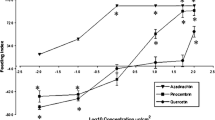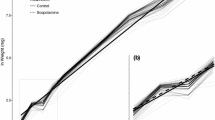Abstract
Nine alkaloids (acridine, aristolochic acid, atropine, berberine, caffeine, nicotine, scopolamine, sparteine, and strychnine) were evaluated as feeding deterrents for gypsy moth larvae (Lymantria dispar (L.); Lepidoptera: Lymantriidae). Our aim was to determine and compare the taste threshold concentrations, as well as the ED50 values, of the nine alkaloids to determine their potency as feeding deterrents. The alkaloids were applied to disks cut from red oak leaves (Quercus rubra) (L.), a plant species highly favored by larvae of this polyphagous insect species. We used two-choice feeding bioassays to test a broad range of biologically relevant alkaloid concentrations spanning five logarithmic steps. We observed increasing feeding deterrent responses for all the alkaloids tested and found that the alkaloids tested exhibited different deterrency threshold concentrations ranging from 0.1 to 10 mM. In conclusion, it appears that this generalist insect species bears a relatively high sensitivity to these alkaloids, which confirms behavioral observations that it avoids foliage containing alkaloids. Berberine and aristolochic acid were found to have the lowest ED50 values and were the most potent antifeedants.



Similar content being viewed by others
References
Ahmad S, Forgash AJ (1975) NADPH-cytochrome-c-reductase: changes in specific activity in gypsy moth larvae. J Insect Physiol 21:85–88
Appel HM, Maines LW (1995) The influence of host plant on gut conditions of gypsy moth (Lymantria dispar) caterpillars. J Insect Physiol 41:241–246
Barbosa P, Krischik VA (1987) Influence of alkaloids on feeding preference of eastern deciduous forest trees by the gypsy moth Lymantria dispar. Am Nat 130:53–69
Barbosa P, Gross P, Provan GJ, Pacheco DY, Stermitz FR (1990) Allelochemicals in foliage of unfavored tree hosts of the gypsy moth, Lymantria dispar L. 1. Alkaloids and other components of Lirodendron tulipifera L. (Magnoliaceae), Acer rubrum L. (Aceraceae), and Cornus florida L. (Cornaceae). J Chem Ecol 16:1719–1730
Bernays EA, Chapman RF (1977) Deterrent chemicals as a basis of oliphagy in Locusta migratoria (L.). Ecol Entomol 2:1–18
Bernays EA, Chapman RF (1994) Host-plant selection by phytophagous insects. Chapman & Hall, New York
Bernays EA, Oppenheim S, Chapman RF, Kwon H, Gould F (2000) Taste sensitivity of insect herbivores to deterrents is greater in specialists than in generalists: a behavioral test of the hypothesis with two closely related caterpillars. J Chem Ecol 26:547–563
Brattsten LB, Wilkinson CF (1977) Herbivore-plant interactions: mixed function oxidases and secondary plant substances. Science 196:1349–1352
Eichenseer H, Mullin C (1997) Antifeedant comparisons of GABA/glycinergic antagonists for diabroticite leaf beetles (Coleoptera: Chrysomelidae). J Chem Ecol 23:71–82
Feyereisen R (1999) Insect P450 enzymes. Annu Rev Entomol 44:507–533
Gibbs RD (1974) Chemotaxonomy of flowering plants, 4 vols. McGill-Queen’s Univ. Press, Montreal, Canada
Glendinning JI (2002) How do herbivorous insects cope with noxious secondary plant compounds in their diet? Entomol Exp Appl 104:15–25
Glendinning JI, Domdom S, Long E (2001) Selective adaptation to noxious foods by a herbivorous insect. J Exp Biol 204:3355–3367
Gröger D (1980) Alkaloids derived from tryptophan and anthranilic acid. In: Bell EA, Charlwood BV (eds) Secondary plant products. Springer-Verlag, New York, pp 128–159
Hartmann T (1991) Alkaloids. In: Rosenthal GA, Berenbaum MR (eds) Herbivores: their interactions with secondary plant metabolites, vol 1, 2nd edn. Academic Press, San Diego, pp 79–121
Hodgson E, Rose RL, Ryu D-Y, Falls G, Blake BL, Levi PE (1995) Pesticide-metabolizing enzymes. Toxicol Lett 82/83:73–81
Huang XP, Renwick JAA (1997) Feeding deterrents and sensitivity suppressors for Pieris rapae larvae in wheat germ diet. J Chem Ecol 23:51–70
Jermy T, Hanson FE, Dethier VG (1968) Induction of specific food preference in lepidopterous larvae. Entomol Exp Appl 11:211–230
Lazarević J, Perić-Maturuga V, Stojković B, Tucić N (2002) Adaptation of the gypsy moth to an unsuitable host plant. Entomol Exp Appl 102:75–86
Leonard DE (1974) Recent developments in ecology and control of the gypsy moth. Annu Rev Entomol 19:197–229
Miller JS, Feeny P (1983) Effects of benzylisoquinoline alkaloids on the larvae of polyphagous Lepidoptera. Oecologia (Berlin) 58:332–339
Miller JC, Hanson PE (1989) Laboratory feeding tests on the development of gypsy moth larvae with references to plant taxa and allelochemicals. Agricultural Experiment Station, Station Bulletin 674
Mosher FH (1915) Food plants of the gypsy moth in America. U.S.D.A. Bulletin No. 250, pp 1–39
Neal JJ (1989) Methylenedioxyphenyl-containing alkaloids and autosynergism. Phytochemistry 28:451–453
Saunders JA, O’Neill NR, Romeo JT (1992) Alkaloid chemistry and feeding specificity of insect herbivores. In: Pelletier SW (ed) Alkaloids: chemical and biological perspective. Springer-Verlag, New York, pp 151–196
Scott JG (1999) Cytochromes P450 and insecticide resistance. Insect Biochem Mol Biol 29:757–777
Seigler DS (1998) Plant secondary metabolism. Kluwer Academic Publishers, Boston, pp 506–512
Shields VDC, Broomell BP, Salako JOB (2003) Host selection and acceptability of selected tree species by gypsy moth larvae, Lymantria dispar (L.). Ann Entomol Soc Am 96:920–926
Shields VDC, Rodgers EJ, Arnold NS, Williams D (2006) Feeding responses to selected alkaloids by gypsy moth larvae, Lymantria dispar (L.). Naturwissenschaften 93:127–130
Wheeler GS, Slansky F Jr, Yu SJ (2001) Food consumption, utilization and detoxification enzyme activity of larvae of three polyphagous noctuid moth species when fed the botanical insecticide rotenone. Entomol Exp Appl 98:225–239
Willaman JJ, Schubert BG (1961) Alkaloid-bearing plants and their contained alkaloids. USDA Techical Bulletin 1234
Wrubel RP, Bernays EA (1990) The relative insensitivity of Manduca sexta larvae to non-host plant secondary compounds. Entomol Exp Appl 54:117–124
Acknowledgements
We gratefully acknowledge Dr. Thomas Heinbockel, Howard University College of Medicine, Washington, D.C. for critically reviewing this manuscript. Many thanks to Mr. Howard Kaplon and Dr. Joel Snodgrass for guidance with the statistical analyses. We also thank USDA-APHIS, Otis Air National Guard Base (Falmouth, Massachusetts) and Robert Bennett (USDA, Beltsville, MD) for kindly supplying us with egg masses and Janelle Akomah for helping with this project. This work was supported by NIH grant 1R15DC007609-01 to V.D.S. and NIH grant GM-58384.
Author information
Authors and Affiliations
Corresponding author
Additional information
Handling Editor: Joseph Dickens.
Rights and permissions
About this article
Cite this article
Shields, V.D.C., Smith, K.P., Arnold, N.S. et al. The effect of varying alkaloid concentrations on the feeding behavior of gypsy moth larvae, Lymantria dispar (L.) (Lepidoptera: Lymantriidae). Arthropod-Plant Interactions 2, 101–107 (2008). https://doi.org/10.1007/s11829-008-9035-6
Received:
Accepted:
Published:
Issue Date:
DOI: https://doi.org/10.1007/s11829-008-9035-6




